Hydrogeological Behaviour and Geochemical Features of Waters in Evaporite-Bearing Low-Permeability Successions: A Case Study in Southern Sicily, Italy
Abstract
Featured Application
Abstract
1. Introduction
2. Study Area
3. Materials and Methods
3.1. Hydrogeological Investigations
3.2. Isotopic Investigations
3.3. Microbiological Analyses: 16S Ribosomal RNA Gene Next Generation Sequencing (NGS)
4. Results and Discussion
4.1. Hydrogeological Features
4.2. Hydrogen and Oxygen Isotopes
4.3. Next-Generation Sequencing Results
5. Hydrogeological Model
- (1)
- The chemical component carrying 3H may also be the cause of increasing δ2/1H. This carrier could be methane formed by degradation of organic matter in an environment where tritium may reach high values, such as sediments rich in organic matter that acquired a high tritium concentration at the time of atomic weapon experiments. For instance, Eyrolle et al. [98] reported high tritium concentrations in the organic portion of the sediments from the Loire River in Western France. These findings “demonstrate that tritium from global atmospheric fallout stored in a sedimentary reservoir for decades as organically bound forms”. However, the presence of a modern organic substance in deep sediments is impossible in undisturbed settings.
- (2)
- The chemical component carrying 3H may be different from that of increasing δ2/1H. Thus, the two processes are separate but correlated. The enrichment in 2H is caused by exchange with methane, whereas the enrichment in 3H is attributed to more or less prolonged groundwater pathways. In this scenario, the deepest investigated groundwater (higher 3H content in C5c) is characterised by a longer residence time and a major link to rainwater precipitated during the 1950s and 1960s. At the same time, a heterogeneous distribution of organic matter and methanogenic archaea within the saturated medium could lead to (i) different amounts of methane and (ii) a more or less prolonged interaction between the gas and groundwater at different depths. Moreover, considering the decrease of hydraulic head with depth and the downward groundwater flow component, the C5a groundwater type (characterised by relatively low δ2/1H and 3H values) may progressively dilute the deepest C5c groundwater type, thus causing a mixing between two waters with extreme δ2/1H and 3H values, namely C5a and C5c.
6. Concluding Remarks
- Hydrogeological investigations and isotopic analyses demonstrated the coexistence of relatively brief to very prolonged groundwater pathways, but everywhere recharged by local precipitation;
- The deuterium content of some samples showed unusual values for groundwater; however, the coupled isotopic-biomolecular approach allowed to demonstrate that these unusual values are due to the interactions between the groundwater and certain gases (H2S and CH4), the presences of which are linked to sulfate-reducing bacteria and methanogenic archaea;
- At this stage of the research, these unusual isotopic content was detected in only one sampling sub-area (C5-cluster); nevertheless, this discrepancy between C5-groundwaters and those sampled in the other available wells is not surprising when taking into consideration the (hydro)geological heterogeneity of the investigated system, as well as the results obtained in a similar setting from the biogeochemical points of view [14,15,16]; in this previous case, a “patchwork” of geochemical and microbiological sub-environments was detected within the whole heterogeneous system, therefore demonstrating the coexistence of different microbial communities (with different microbial activity) also at a metric or decametric scale.
Author Contributions
Funding
Acknowledgments
Conflicts of Interest
References
- Hsu, K.J.; Ryan, W.B.F.; Cita, M.B. Late miocene desiccation of the Mediterranean. Nature 1973, 242, 240–244. [Google Scholar] [CrossRef]
- Krijgsman, W.; Hilgen, F.J.; Raffi, I.; Sierro, F.J.; Wilson, D.S. Chronology, causes and progression of the Messinian salinity crisis. Nature 1999, 400, 652–655. [Google Scholar] [CrossRef]
- Vidal, L.; Bickert, T.; Wefer, G.; Rohl, U. Late Miocene stable isotope stratigraphy of SE Atlantic ODP Site 1085: Relation to Messinian events. Mar. Geol. 2002, 180, 71–85. [Google Scholar] [CrossRef]
- Duggen, S.; Hoernie, K.; van Den Bogaard, V.; Rqpke, L.; Morgan, J.P. Deep roots of the Messinian salinity crisis. Nature 2003, 422, 602–606. [Google Scholar] [CrossRef]
- Selli, R., II. Messiniano Mayer-Eymar. Proposta di un neostratotipo (The Messinian Mayer-Eymar. A proposal for a neostratotype). G. Geol. 1960, 28, 1–33. [Google Scholar]
- Hsü, K.; Montadert, L.; Bernoulli, D.; Cita, M.B.; Erickson, A.; Garrison, R.E.; Kidd, R.B.; Melieres, F.; Muller, C.; Wright, R. History of the Mediterranean salinity crisis. Nature 1977, 267, 399–403. [Google Scholar] [CrossRef]
- Butler, R.W.H.; Maniscalco, R.; Sturiale, G.; Grasso, M. Stratigraphic variations control deformation patterns in evaporite basins: Messinian examples, onshore and offshore Sicily (Italy). J. Geol. Soc. Lond. 2015, 172, 113–124. [Google Scholar] [CrossRef]
- Balestra, M.; Corrado, S.; Aldega, L.; Gasparo Morticelli, M.; Sulli, A.; Rudkiewicz, J.L.; Sassi, W. Thermal and structural modeling of the Scillato wedge-top basin source-to-sink system: Insights into the Sicilian fold-and-thrust belt evolution (Italy). Geol. Soc. Am. Bull. 2019, 131, 1763–1782. [Google Scholar] [CrossRef]
- Gasparo Morticelli, M.; Valenti, V.; Catalano, R.; Sulli, A.; Agate, M.; Avellone, G.; Gugliotta, C. Deep controls on foreland basin system evolution along the sicilian fold and thrust belt. Bull. Soc. Géol. Fr. 2015, 186, 273–290. [Google Scholar] [CrossRef]
- Conti, A.; Sacchi, E.; Chiarle, M.; Martinelli, G.; Zuppi, G.M. Geochemistry of the formation waters in the Po plain (Northern Italy): An overview. Appl. Geochem. 2000, 15, 51–65. [Google Scholar] [CrossRef]
- Pingue, L.; Marrone, G. Su alcune acque mineralizzate della provincia di Avellino (Some insight on a mineralized water in the Avellino province). Econ. Irp. 1972, 1, 5–16. [Google Scholar]
- Di Nocera, S.; Imperato, M.; Matano, F.; Stanzione, D.; Valentino, G.M. Caratteri geologici ed idrogeologici della valle di Ansanto (Irpinia Centrale, Appennino Campano-Lucano) (Geological and hydrogeological features of the Ansanto Valley (Irpinia, Campano-Lucano Appenine). Boll. Soc. Geol. Ital. 1999, 118, 395–406. [Google Scholar]
- Ortolani, F.; De Gennaro, M.; Ferreri, M.; Ghiara, M.R.; Stanzione, D.; Zenone, F. Prospettive geotermiche dell’Irpinia centrale (Appennino Meridionale): Studio geologico-strutturale e geochimica (Geothermal perspectives of the central Irpinia (Southern Appenine): Geological, structural ande geochemical studies). Boll. Soc. Geol. Ital. 1981, 100, 139–159. [Google Scholar]
- Celico, F.; Capuano, P.; De Felice, V.; Naclerio, G. Hypersaline groundwater genesis assessment through a multidisciplinary approach: The case of Pozzo del Sale spring (southern Italy). Hydrogeol. J. 2008, 16, 1441–1451. [Google Scholar] [CrossRef]
- Boschetti, T.; De Felice, V.; Celico, F. The Pozzo del Sale waters (Irpinia, Southern Apennines, Italy): Chemical—Isotope salt effects and paleoenvironmental implications for Late Messinian evaporates. Aquat. Geochem. 2013, 19, 303–322. [Google Scholar] [CrossRef]
- Petrella, E.; Bucci, A.; Ogata, K.; Zanini, A.; Naclerio, G.; Chelli, A.; Francese, R.; Boschetti, T.; Pittalis, D.; Celico, F. Hydrodynamics in evaporate-bearing fine-grained successions investigated through an interdisciplinary approach: A test study in Southern Italy. Geofluids 2018. [Google Scholar] [CrossRef]
- Eastoe, C.J.; Long, A.; Knauth, P. Stable chlorine isotopes in the Palo Duro Basin, Texas: Evidence for preservation of Permian evaporate brines. Geochim. Cosmochim. Acta 1999, 63, 1375–1382. [Google Scholar] [CrossRef]
- Andreo, B.; Gil-Márquez, J.M.; Mudarra, M.; Linares, L.; Carrasco, F. Hypothesis on the hydrogeological context of wetland areas and springs related to evaporitic karst aquifers (Málaga, Córdoba and Jaén provinces, Southern Spain). Environ. Earth Sci. 2016, 75, 759. [Google Scholar] [CrossRef]
- Gil-Màrquez, J.M.; Barberà, J.A.; Andreo, B.; Mudarra, M. Hydrological and geochemical processes constraining groundwater salinity in wetland areas related to evaporitic (karst) systems. A case study from Southern Spain. J. Hydrol. 2017, 544, 538–554. [Google Scholar] [CrossRef]
- Lyu, M.; Pang, A.; Yin, L.; Zhang, J.; Huang, T.; Yang, S.; Li, Z.; Wang, X.; Gulbostan, T. The control of groundwater flow systems and geochemical processes on groundwater chemistry: A case study in Wushenzhao Basin, NW China. Water 2019, 11, 790. [Google Scholar] [CrossRef]
- Acero, P.; Auqué, L.F.; Galve, J.P.; Gutiérrez, F.; Carbonel, D.; Gimeno, M.J.; Yechieli, Y.; Asta, M.P.; Gómez, J.B. Evaluation of geochemical and hydrogeological processes by geochemical modeling in an area affected by evaporate karstification. J. Hydrol. 2015, 529, 1874–1889. [Google Scholar] [CrossRef]
- Chiesi, M.; de Waele, J.; Forti, P. Origin and evolution of a salty gypsum/anhydrite karst spring: The case of Poiano (Northern Apennines, Italy). Hydrogeol. J. 2010, 18, 1111–1124. [Google Scholar] [CrossRef]
- Zhu, S.; Zhang, F.; Zhang, Z.; Kung, H.; Yushanjiang, A. Hydrogen and oxygen isotope composition and water quality evaluation for different water bodies in the Ebinur Lake watershed, Northwestern China. Water 2019, 11, 2067. [Google Scholar] [CrossRef]
- Porowski, A.; Porowska, D.; Halas, S. Identification of sulfate sources and biogeochemical processes in an aquifer affected by peatland: Insights from monitoring the isotopic composition of groundwater sulfate in Kampinos National Park, Poland. Water 2019, 11, 1388. [Google Scholar] [CrossRef]
- Petrella, E.; Celico, F. Mixing of water in a carbonate aquifer, southern Italy, analysed through stable isotope investigations. Int. J. Speleol. 2013, 42, 25–33. [Google Scholar] [CrossRef]
- Walker, D.; Parkin, G.; Gowing, J.; Haile, A.T. Development of a Hydrogeological Conceptual Model for Shallow Aquifers in the Data Scarce Upper Blue Nile Basin. Hydrology 2019, 6, 43. [Google Scholar] [CrossRef]
- Duckett, K.A.; Langman, J.B.; Bush, J.H.; Brooks, E.S.; Dunlap, P.; Welker, J.M. Isotopic Discrimination of Aquifer Recharge Sources, Subsystem Connectivity and Flow Patterns in the South Fork Palouse River Basin, Idaho and Washington, USA. Hydrology 2019, 6, 15. [Google Scholar] [CrossRef]
- Eissa, M.A. Application of Multi-Isotopes and Geochemical Modeling for Delineating Recharge and Salinization Sources in Dahab Basin Aquifers (South Sinai, Egypt). Hydrology 2018, 5, 41. [Google Scholar] [CrossRef]
- Clauer, N.; Techer, I.; Chaudhuri, S. Geochemical Tracing of Potential Hydraulic Connections between Groundwater and Run-Off Water in Northeastern Kansas, USA. Hydrology 2017, 4, 56. [Google Scholar] [CrossRef]
- Bucci, A.; Petrella, E.; Naclerio, G.; Allocca, V.; Celico, F. Microorganisms as contaminants and natural tracers: A 10-year research in some carbonate aquifers (southern Italy). Environ. Earth Sci. 2015, 74, 173–184. [Google Scholar] [CrossRef]
- Bucci, A.; Petrella, E.; Celico, F.; Hynds, P.D.; Naclerio, G. The use of molecular approaches in hydrogeological studies: Carbonate aquifers in Southern Italy. Hydrogeol. J. 2017, 25, 1017–1031. [Google Scholar] [CrossRef]
- Bucci, A.; Petrella, E.; Naclerio, G.; Gambatese, S.; Celico, F. Bacterial migration through low-permeability fault zones in compartmentalised aquifer systems: A case study in Southern Italy. Int. J. Speleol. 2014, 43, 273–281. [Google Scholar] [CrossRef]
- Rizzo, P.; Petrella, E.; Bucci, A.; Salvioli Mariani, E.; Chelli, A.; Sanangelantoni, A.M.; Raimondo, M.; Quagliarini, A.; Celico, F. Studying hydraulic interconnections in low-permeability media by using bacterial communities as natural tracers. Water 2020, 12, 1795. [Google Scholar] [CrossRef]
- Bucci, A.; Naclerio, G.; Allocca, V.; Celico, P.; Celico, F. Potential use of microbial community investigations to analyze hydrothermal systems behaviour: The case of Ischia island, southern Italy. Hydrol. Process. 2011, 25, 1866–1873. [Google Scholar] [CrossRef]
- Rizzo, P.; Bucci, A.; Sanangelantoni, A.M.; Iacumin, P.; Celico, F. Coupled Microbiological–Isotopic Approach for Studying Hydrodynamics in Deep Reservoirs: The Case of the Val d’Agri Oilfield (Southern Italy). Water 2020, 12, 1483. [Google Scholar] [CrossRef]
- Naclerio, G.; Fardella, G.; Marzullo, G.; Celico, F. Filtration of Bacillus subtilis and Bacillus cereus spores in a pyroclastic topsoil, carbonate Apennines, southern Italy. Colloids Surf. B Biointerfaces 2009, 70, 25–28. [Google Scholar] [CrossRef] [PubMed]
- Gugliotta, C.; Gasparo Morticelli, M.; Avellone, G.; Agate, M.; Barchi, M.R.; Albanese, C.; Valenti, V.; Catalano, R. Middle Miocene—Early Pliocene wedge-top basins of North-Western Sicily (Italy). Constraints for the tectonic evolution of a “non-conventional” thrust belt, affected by transpression. J. Geol. Soc. Lond. 2014, 171, 211–226. [Google Scholar] [CrossRef]
- Avellone, G.; Barchi, M.R.; Catalano, R.; Gasparo Morticelli, M.; Sulli, A. Interference between shallow and deep-seated structures in the sicilian fold and thrust belt, Italy. J. Geol. Soc. Lond. 2010, 167, 109–126. [Google Scholar] [CrossRef]
- de Waele, J.; Piccini, L.; Columbu, A.; Madonia, G.; Vattano, M.; Calligaris, C.; D’Angeli, I.; Parise, M.; Chiesi, M.; Sivelli, M.; et al. Evaporite karst in Italy: A review. Int. J. Speleol. 2017, 46, 137–168. [Google Scholar] [CrossRef]
- Caracausi, A.; Sulli, A. Outgassing of mantle volatiles in compressional tectonic regime away from volcanism: The role of continental delamination. Geochem. Geophys. 2019, 20, 2007–2020. [Google Scholar] [CrossRef]
- Di Maggio, C.; Madonia, G.; Parise, M.; Vattano, M. Karst of Sicily and its conservation. J. Cave Karst Stud. 2012, 74, 157–172. [Google Scholar] [CrossRef]
- Decima, D.; Wezel, F.C. Late Miocene evaporites of the central Sicilian Basin, Italy. Initial Rep. Deep Sea Drill. Proj. 1973, 13, 1234–1241. [Google Scholar]
- Roveri, M.; Schreiber, B.C.; Iaccarino, S.M.; Vitale, F.P.; Lugli, S.; Caruso, A.; Lucchi, F.R. Clastic vs. primary precipitated evaporites in the messinian sicilian basins. Ateneo Parm. Acta Nat. 2006, 42, 125–199. [Google Scholar]
- Decima, A.; Bommarito, S.; La Rosa, N.; Aiello, R. Foglio 636—Agrigento. Carta Geologica d’Italia Alla Scala 1:50.000; Servizio Geologico d’Italia, Istituto Superiore per la Protezione e la Ricerca Ambientale (ISPRA): Roma, Italy, 1972. [Google Scholar]
- Cappadonia, C.; Coratza, P.; Agnesi, V.; Soldati, M. Malta and Sicily joined by geoheritage enhancement and geotourism within the framework of land management and development. Swiss J. Geosci. 2018, 8, 253. [Google Scholar] [CrossRef]
- Abiye, T.; Shaduka, I. Radioactive Seepage through Groundwater Flow from the Uranium Mines, Namibia. Hydrology 2017, 4, 11. [Google Scholar] [CrossRef]
- International Atomic Energy Agency. Water and Environment News; IAEA: Vienna, Austria, 1998. [Google Scholar]
- Milani, C.; Hevia, A.; Foroni, E.; Duranti, S.; Turroni, F.; Lugli, G.A.; Sanchez, B.; Martín, R.; Gueimonde, M.; van Sinderen, D.; et al. Assessing the Fecal Microbiota: An Optimized Ion Torrent 16S rRNA Gene-Based Analysis Protocol. PLoS ONE 2013, 8, e68739. [Google Scholar] [CrossRef]
- Fischer, M.A.; Güllert, S.; Neulinger, S.C.; Streit, W.R.; Schmitz, R.A. Evaluation of 16S rRNA gene primer pairs for monitoring microbial community structures showed high reproducibility within and low comparability between datasets generated with multiple archaeal and bacterial primer pairs. Front. Microbiol. 2016, 7, 1297. [Google Scholar] [CrossRef]
- Caporaso, J.G.; Kuczynski, J.; Stombaugh, J.; Bittinger, K.; Bushman, F.D.; Costello, E.K.; Fierer, N.; Gonzalez Peña, A.; Goodrich, J.K.; Gordon, J.I.; et al. QIIME allows analysis of high-throughput community sequencing data. Nat. Methods 2010, 7, 335–336. [Google Scholar] [CrossRef]
- Callahan, B.J.; McMurdie, P.J.; Rosen, M.J.; Han, A.W.; Johnson, A.J.; Holmes, S.P. DADA2: High-resolution sample inference from Illumina amplicon data. Nat. Methods 2016, 13, 581–583. [Google Scholar] [CrossRef]
- Bokulich, N.A.; Kaehler, B.D.; Rideout, J.R.; Dillon, M.; Bolyen, E.; Knight, R.; Huttley, G.A.; Caporaso, G.J. Optimizing taxonomic classification of marker-gene amplicon sequences with QIIME 2’s q2-feature-classifier plugin. Microbiome 2018, 6, 90. [Google Scholar] [CrossRef]
- Quast, C.; Pruesse, E.; Yilmaz, P.; Gerken, J.; Schweer, T.; Yarza, P.; Peplies, J.; Glöckner, F.O. The SILVA ribosomal RNA gene database project: Improved data processing and web-based tools. Nucleic Acids Res. 2012, 41, 590–596. [Google Scholar] [CrossRef] [PubMed]
- Freeze, R.A.; Witherspoon, P.A. Theoretical analysis of regional groundwater flow: 2. Effect of water-table configuration and subsurface permeability variation. Water Resour. Res. 1967, 3, 623–634. [Google Scholar] [CrossRef]
- Grassa, F.; Favara, R.; Valenza, M. Moisture source in the Hyblean Mountains region (South-Eastern Sicily, Italy): Evidence from stable isotopes signature. Appl. Geochem. 2006, 21, 2082–2095. [Google Scholar] [CrossRef]
- Liotta, M.; Favara, R.; Valenza, M. Isotopic composition of the precipitations in the Central Mediterranean: Origin marks and orographic precipitation effects. J. Geophys. Res. 2006, 111, D19302. [Google Scholar] [CrossRef]
- Liotta, M.; Brusca, L.; Grassa, F.; Inguaggiato, S.; Longo, M.; Madonia, P. Geochemistry of rainfall at Stromboli volcano (Aeolian Islands): Isotopic composition and plume-rain interaction. Geochem. Geophys. Geosyst. 2006, 7, Q07006. [Google Scholar] [CrossRef]
- Liotta, M.; Bellissimo, S.; Favara, R.; Valenza, M. Isotopic composition of single rain events in the Central Mediterranean. J. Geophys. Res. 2008, 113, D16304. [Google Scholar] [CrossRef]
- Fontana, M.; Grassa, F.; Cusimano, G.; Favara, R.; Hauser, S.; Scaletta, R. Geochemistry and potential use of groundwater in the Rocca Busambra area (Sicily, Italy). Environ. Geol. 2009, 57, 885–898. [Google Scholar] [CrossRef]
- Liotta, M.; Grassa, F.; D’Alessandro, W.; Favara, R.; Gagliano, E.; Candela, A.; Pisciotta, C.; Scaletta, R. Isotopic composition of precipitation and groundwater in Sicily, Italy. Appl. Geochem. 2013, 34, 199–206. [Google Scholar] [CrossRef]
- Madonia, P.; D’Aleo, R.; Di Maggio, C.; Favara, R.; Hartwig, A. The use of shallow dripwater as an isotopic marker of seepage in karst areas: A comparison between Western Sicily (Italy) and the Harz Mountains (Germany). Appl. Geochem. 2013, 34, 231–239. [Google Scholar] [CrossRef]
- Giustini, F.; Brilli, M.; Patera, A. Mapping oxygen stable isotopes of precipitation in Italy. J. Hydrol. Reg. Stud. 2016, 8, 162–181. [Google Scholar] [CrossRef]
- Petrella, E.; Celico, F. Heterogeneous aquitard properties in sedimentary successions in the Apennine chain: Case studies in southern Italy. Hydrol. Process. 2009, 23, 3365–3371. [Google Scholar] [CrossRef]
- Segadelli, S.; Vescovi, P.; Ogata, K.; Chelli, A.; Zanini, A.; Boschetti, T.; Petrella, E.; Toscani, L.; Gargini, A.; Celico, F. A conceptual hydrogeological model of ophiolitic aquifers (serpentinized peridodite): The test example of Mt. Prinzera (northern Italy). Hydrol. Process. 2017, 31, 1058–1073. [Google Scholar] [CrossRef]
- Morgenstern, U.; Stewart, M.K.; Stenger, R. Dating of streamwater using tritium in a post nuclear bomb pulse world: Continuous variation of mean transit time with streamflow. Hydrol. Earth Syst. Sci. 2010, 14, 2289–2301. [Google Scholar] [CrossRef]
- Harms, P.A.; Visser, A.; Moran, J.E.; Esser, B.K. Distribution of tritium in precipitation and surface water in California. J. Hydrol. 2016, 534, 63–72. [Google Scholar] [CrossRef]
- Fernández-Martínez, J.; Pujalte, M.J.; García-Martínez, J.; Mata, M.; Garay, E.; Rodríguez-Valera, F. Description of Alcanivorax venustensis sp. nov. and reclassification of Fundibacter jadensis DSM 12178T (Bruns and Berthe-Corti 1999) as Alcanivorax jadensis comb. nov., members of the emended genus Alcanivorax. Int. J. Syst. Evol. Micr. 2003, 53, 331–338. [Google Scholar] [CrossRef]
- Espinosa, E.; Marco-Noales, E.; Gomez, D.; Lucas-Elío, P.; Ordax, M.; Garcías-Bonet, N.; Sanchez-Amat, A. Taxonomic study of Marinomonas strains isolated from the seagrass Posidonia oceanica, with descriptions of Marinomonas balearica sp. nov. and Marinomonas pollencensis sp. nov. Int. J. Syst. Evol. Microbiol. 2010, 60, 93–98. [Google Scholar] [CrossRef]
- Rodriguez-Valera, F.; Ruiz-Berraquero, F.; Ramos-Cormenzana, A. Characteristics of the heterotrophic bacterial populations in hypersaline environments of different salt concentrations. Microb. Ecol. 1981, 7, 235–243. [Google Scholar] [CrossRef]
- Pati, A.; Gronow, S.; Lapidus, A.; Copeland, A.; Del Rio, T.G.; Nolan, M.; Chertkov, O. Complete genome sequence of Arcobacter nitrofigilis type strain (CIT). Stand. Genom. Sci. 2010, 2, 300. [Google Scholar] [CrossRef]
- Rosenberg, A. Pseudomonas halodurans sp. nov., a halotolerant bacterium. Arch. Microbiol. 1983, 136, 117–123. [Google Scholar] [CrossRef]
- Suzuki, D.; Li, Z.; Zhang, C.; Katayama, A. Reclassification of Desulfobacterium anilini as Desulfatglans anilini comb. Nov. within Desulfatiglans gen. nov., and description of a 4-chlorophenol-degrading sulfate-reducing bacterium, Desulfatiglans parachlorophenolica sp. nov. Int. J. Syst. Evol. Microbiol. 2014, 64, 3081–3086. [Google Scholar] [CrossRef]
- Sigalevich, P.; Baev, M.V.; Teske, A.; Cohen, Y. Sulfate reduction and possible aerobic metabolism of the sulfate-reducing bacterium Desulfovibrio oxyclinae in a chemostat coculture with Marinobacter sp. strain MB under exposure to increasing oxygen concentrations. Appl. Environ. Microbiol. 2000, 66, 5013–5018. [Google Scholar] [CrossRef] [PubMed]
- Burns, J.L.; DiChristina, T.J. Anaerobic respiration of elemental sulfur and thiosulfate by Shewanella oneidensis MR-1 requires psrA, a homolog of the phsA gene of Salmonella enterica serovar typhimurium LT2. Appl. Environ. Microbiol. 2009, 75, 5209–5217. [Google Scholar] [CrossRef] [PubMed]
- Jørgensen, B.B.; Bak, F. Pathways and microbiology of thiosulfate transformations and sulfate reduction in a marine sediment (Kattegat, Denmark). Appl. Environ. Microbiol. 1991, 57, 847–856. [Google Scholar] [CrossRef] [PubMed]
- Könneke, M.; Bernhard, A.E.; José, R.; Walker, C.B.; Waterbury, J.B.; Stahl, D.A. Isolation of an autotrophic ammonia-oxidizing marine archaeon. Nature 2005, 437, 543–546. [Google Scholar] [CrossRef] [PubMed]
- Schoop, G. Halococcus litoralis, ein obligat halophiler Farbstoffbildner. Dtsch Tierarztl Wochenschr 1935, 43, 817–820. [Google Scholar]
- Boone, D.R. Methanobacterium. In Bergey’s Manual of Systematics of Archaea and Bacteria; Wiley: Hoboken, NJ, USA, 2015; pp. 1–8. [Google Scholar]
- Sprenger, W.W.; van Belzen, M.C.; Rosenberg, J.; Hackstein, J.H.; Keltjens, J.T. Methanomicrococcus blatticola gen. nov., sp. nov., a methanol-and methylamine-reducing methanogen from the hindgut of the cockroach Periplaneta americana. Int. J. Syst. Evol. Microbiol. 2000, 50, 1989–1999. [Google Scholar] [CrossRef]
- Holt, J.G.; Krieg, N.R.; Sneath, P.H.A.; Staley, J.T. Bergey’s Manual of Determinative Bacteriology; William and Wilkins Company: Baltimore, MD, USA, 1994; p. 724. [Google Scholar]
- Freeze, R.A.; Cherry, J.A. Groundwater; Prentice-Hall: Englewood Cliffs, NJ, USA, 1979; p. 604. ISBN 978-01-3365-312-0. [Google Scholar]
- Drogue, C. Structure de certains aquifers karstiques d’apres les resultants de traveaux de forage. CR Acad. Sci. Paris 1974, 278, 2621–2624. [Google Scholar]
- Prtoljan, B.; Kapelj, S.; Dukaric, F.; Vlahovic, I.; Mrinjek, E. Hydrochemical and isotopic evidences for definition of tectonically controlled catchment areas of the Konovle area spring (SE Dalmatia, Croatia). J. Geochem. Explor. 2012, 112, 285–296. [Google Scholar] [CrossRef]
- La Vigna, F.; Mazza, R.; Capelli, G. Detecting the flow relationships between deep and shallow aquifers in an exploited groundwater system, using long-term monitoring data and quantitative hydrogeology: The Acque Albule basin case (Rome, Italy). Hydrol. Process. 2013, 27, 3159–3173. [Google Scholar] [CrossRef]
- Agosta, F.; Prasad, M.; Aydin, A. Physical properties of carbonate fault rocks, Fucino basin (Central Italy): Implications for fault seal in platform carbonates. Geofluids 2007, 7, 19–32. [Google Scholar] [CrossRef]
- Petrella, E.; Aquino, D.; Fiorillo, F.; Celico, F. The effect of low-permeability fault zones on groundwater flow in a compartmentalized system. Experimental evidence from a carbonate aquifer (Southern Italy). Hydrol. Process. 2015, 29, 1577–1587. [Google Scholar] [CrossRef]
- Hernandez-Diaz, R.; Petrella, E.; Bucci, A.; Naclerio, G.; Feo, A.; Sferra, G.; Chelli, A.; Zanini, A.; Gonzales-Hernandez, P.; Celico, F. Integrating hydrogeological and microbiological data and modelling to characterize the hydraulic features and behavior of coastal carbonate aquifers: A case in Western Cuba. Water 2019, 11, 1989. [Google Scholar] [CrossRef]
- Mangin, A. Contribution à L’étude Hydrodynamique des Aquiferes Karstiques. Ph.D. Thesis, University de Dijon, Dijon, France, 1975. [Google Scholar]
- Mangin, A. Karst hydrogeology. In Groundwater Ecology; Gibert, J., Danielopol, D.L., Stanford, J.A., Eds.; Academic Press: San Diego, CA, USA, 1994; pp. 43–67. [Google Scholar]
- Segadelli, S.; Vescovi, P.; Chelli, A.; Petrella, E.; De Nardo, M.T.; Gargini, A.; Celico, F. Hydrogeological mapping of heterogeneous, multi-layered ophiolitic aquifers: The test example of Mt. Prinzera (northern Apennines, Italy). J. Maps 2017, 13, 737–746. [Google Scholar] [CrossRef]
- Horita, J.; Wesolowski, D.J. Liquid-vapor fractionation of oxygen and hydrogen isotopes of water from the freezing to the critical temperature. Geochim. Cosmochim. Acta 1994, 58, 3425–3437. [Google Scholar] [CrossRef]
- Galley, M.R.; Miller, A.I.; Atherly, J.F.; Mohn, M. GS process-physical properties: Chalk River, Ontario, Canada, Atomic Energy of Canada Limited, AECL-4225. In Environmental Isotopes in Hydrogeology; Clark, I., Fritz, P., Eds.; Lewis Publisher: Boca Reton, FL, USA, 1972. [Google Scholar]
- Horibe, Y.; Craig, H. D/H fractionation in the system methane-hydrogen-water. Geochim. Cosmochim. Acta 1995, 59, 5209–5217. [Google Scholar] [CrossRef]
- Meister, P.; Liu, B.; Ferdelman, T.G.; Jørgensen, B.B.; Khalili, A. Control of sulphate and methane distributions in marine sediments by organic matter reactivity. Geochim. Cosmochim. Acta 2013, 104, 183–193. [Google Scholar] [CrossRef]
- Peketi, A.; Mazumdar, A.; Spk, P. Influence of dual sulfate reduction pathways on pore-fluid chemistry and occurrences of methane hydrate in sediment cores (IODP-353) off Mahanadi basin, Bay of Bengal. Geochem. J. 2020, 54, 1–11. [Google Scholar] [CrossRef]
- Liu, Q.; Wu, X.; Wang, X.; Jin, Z.; Zhu, D.; Meng, Q.; Huang, S.; Liu, J.; Fu, Q. Carbon and hydrogen isotopes of methane, ethane, and propane: A review of genetic identification of natural gas. Earth-Sci. Rev. 2019, 190, 247–272. [Google Scholar] [CrossRef]
- Parkhurst, D.L.; Appelo, C.A.J. Description of Input and Examples for PHREEQC Version 3-A Computer Program for Speciation, Batch-Reaction, One-Dimensional Transport, and Inverse Geochemical Calculations. In Geological Survey Techniques and Methods; U.S. Department of the Interior; U.S. Geological Survey: Denver, CO, USA, 2013; Book 6, Chapter A43. Available online: https://pubs.usgs.gov/tm/06/a43/ (accessed on 1 July 2020).
- Eyrolle, F.; Copard, Y.; Lepage, H.; Ducros, L.; Morereau, A.; Grosbois, C.; Cossonnet, C.; Gurriaran, R.; Booth, S.; Desmet, M. Evidence for tritium persistence as organically bound forms in river sediments since the past nuclear weapon tests. Sci. Rep. 2009, 9, 11487. [Google Scholar] [CrossRef]
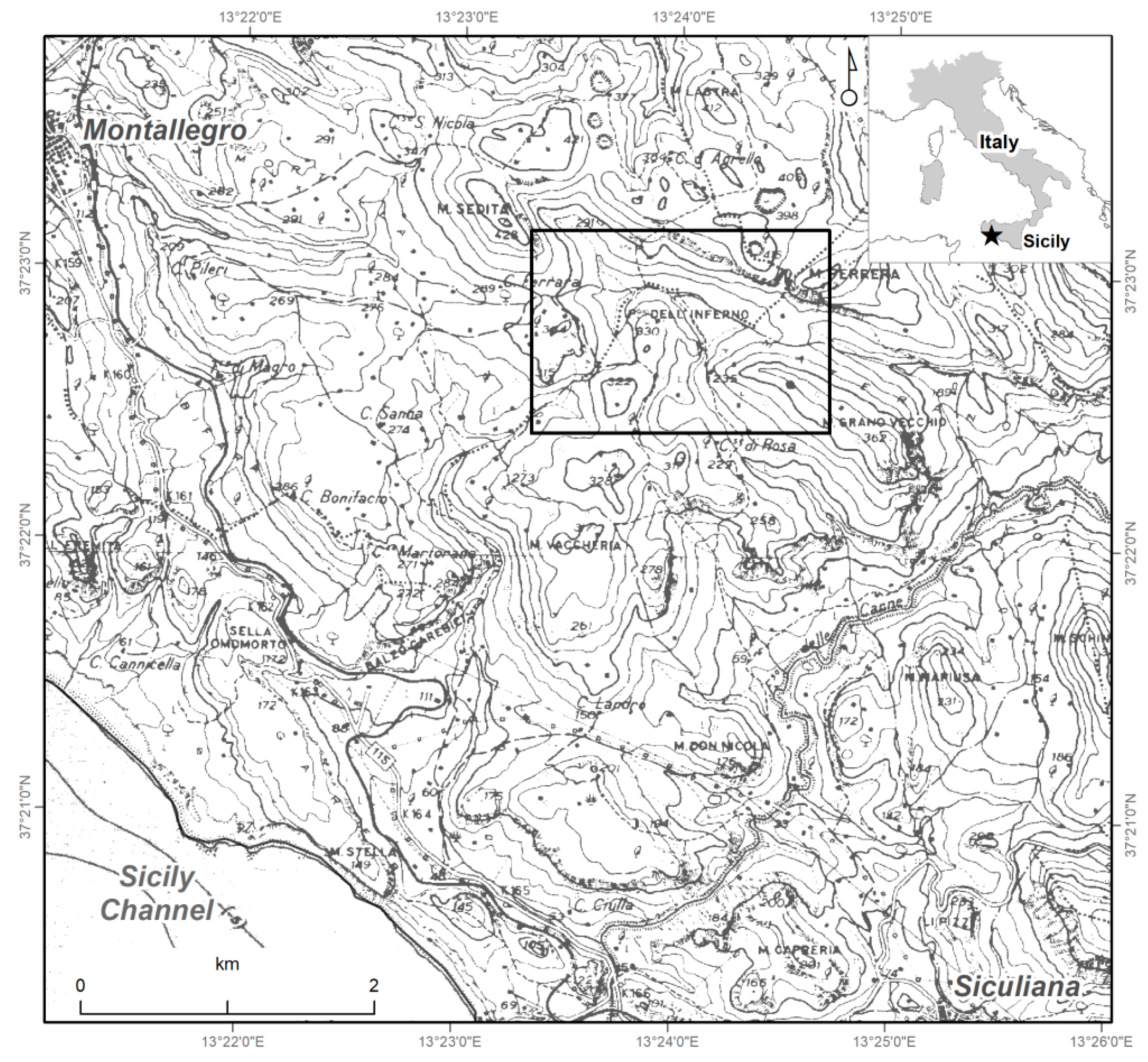
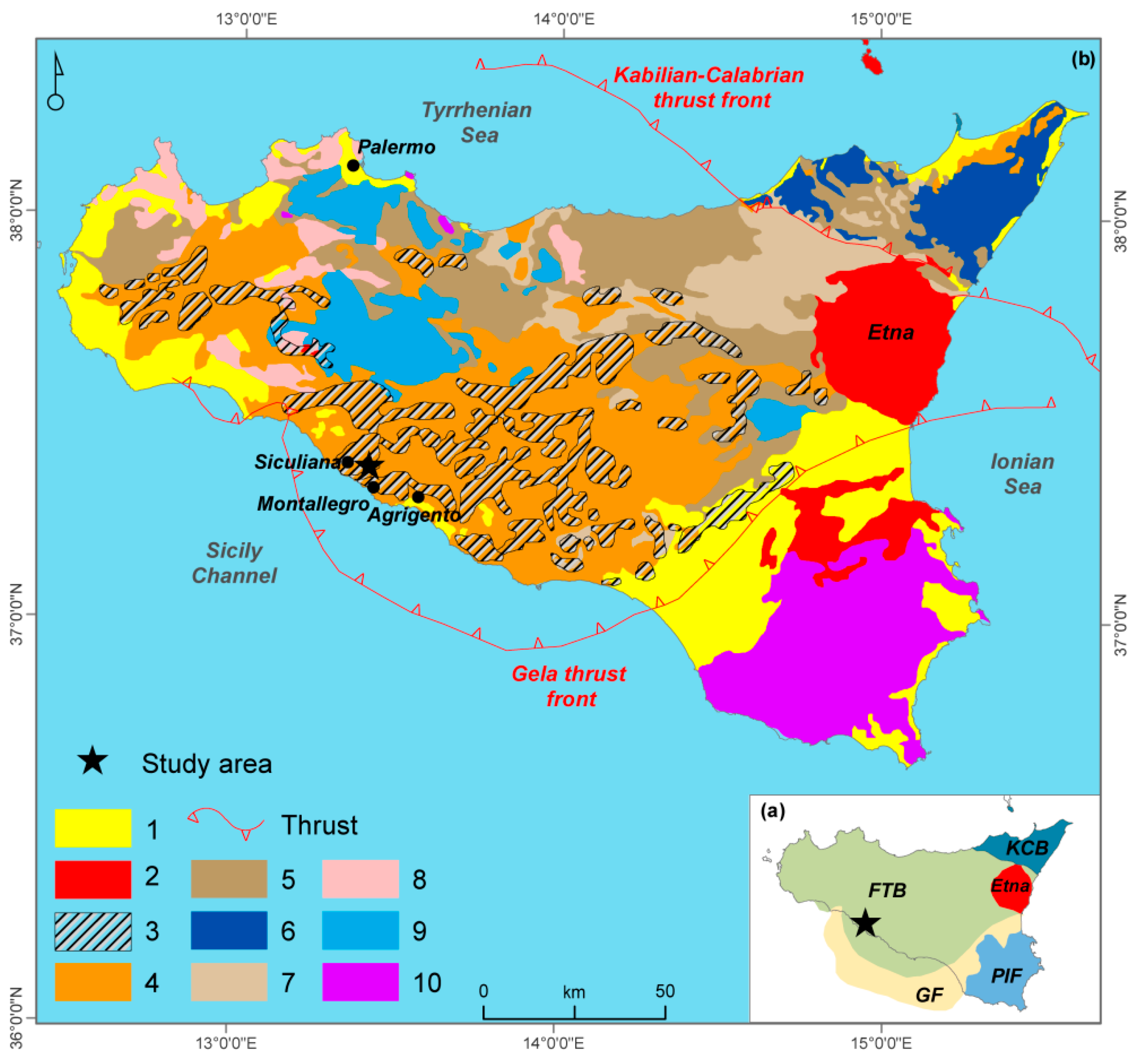
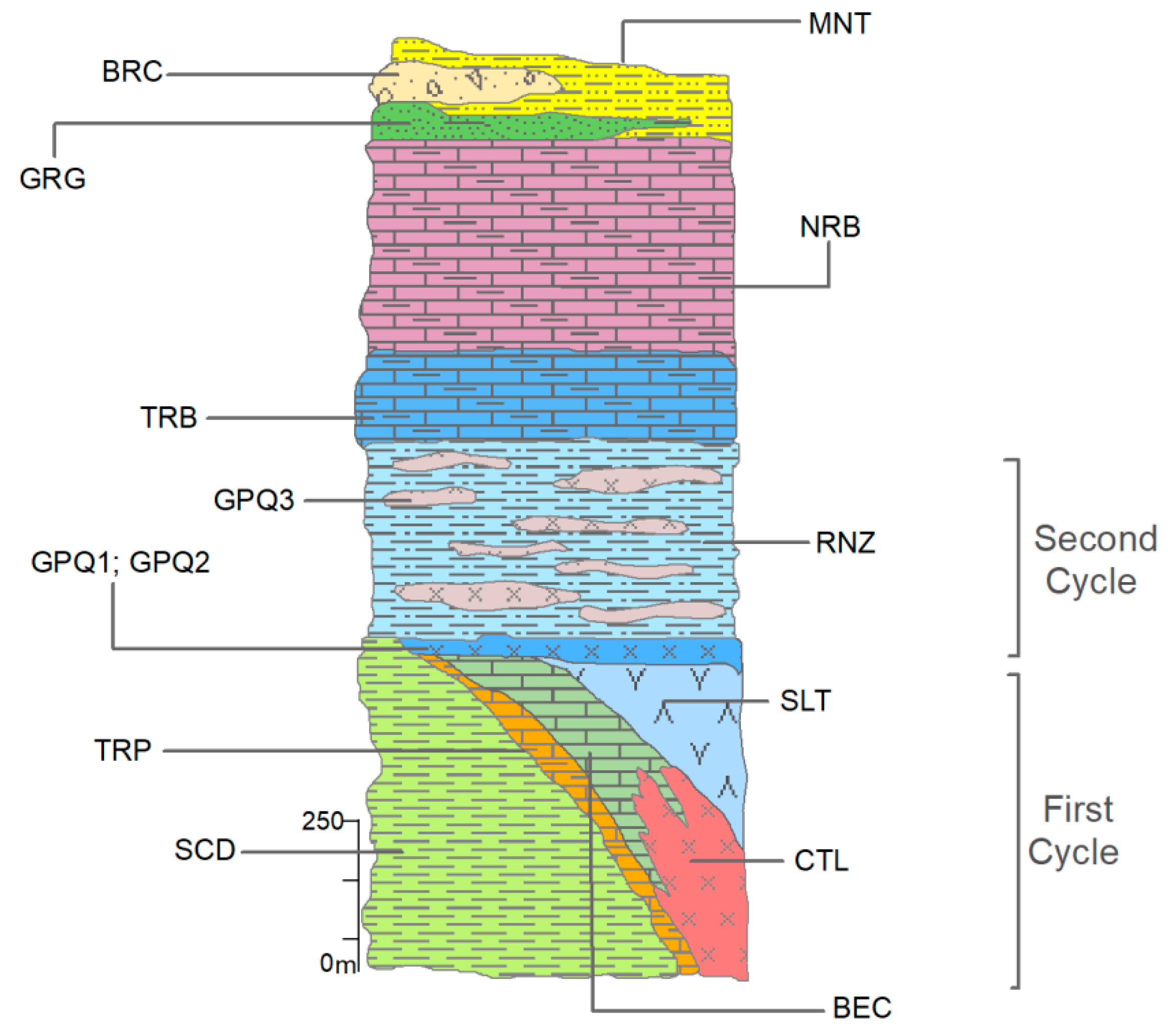

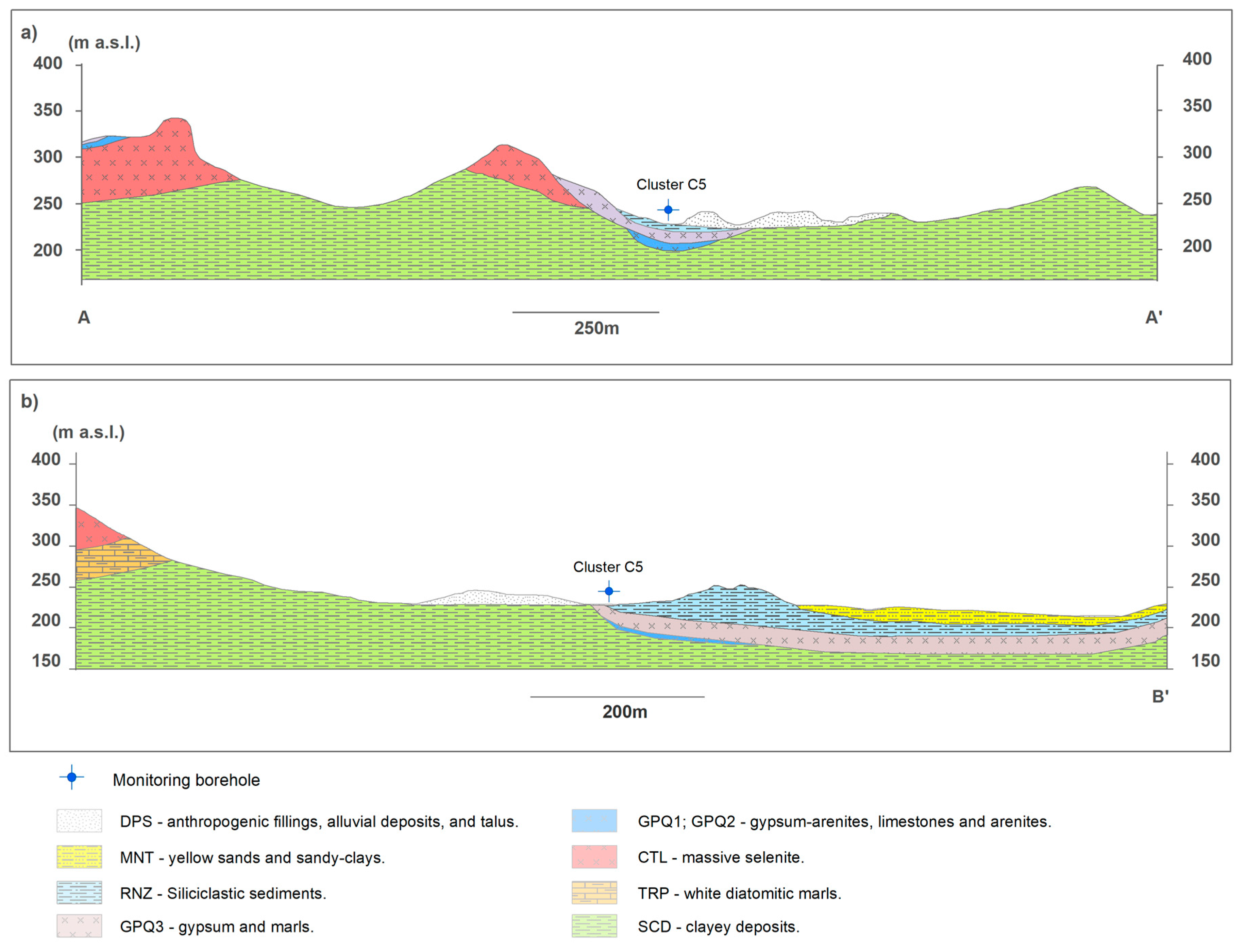
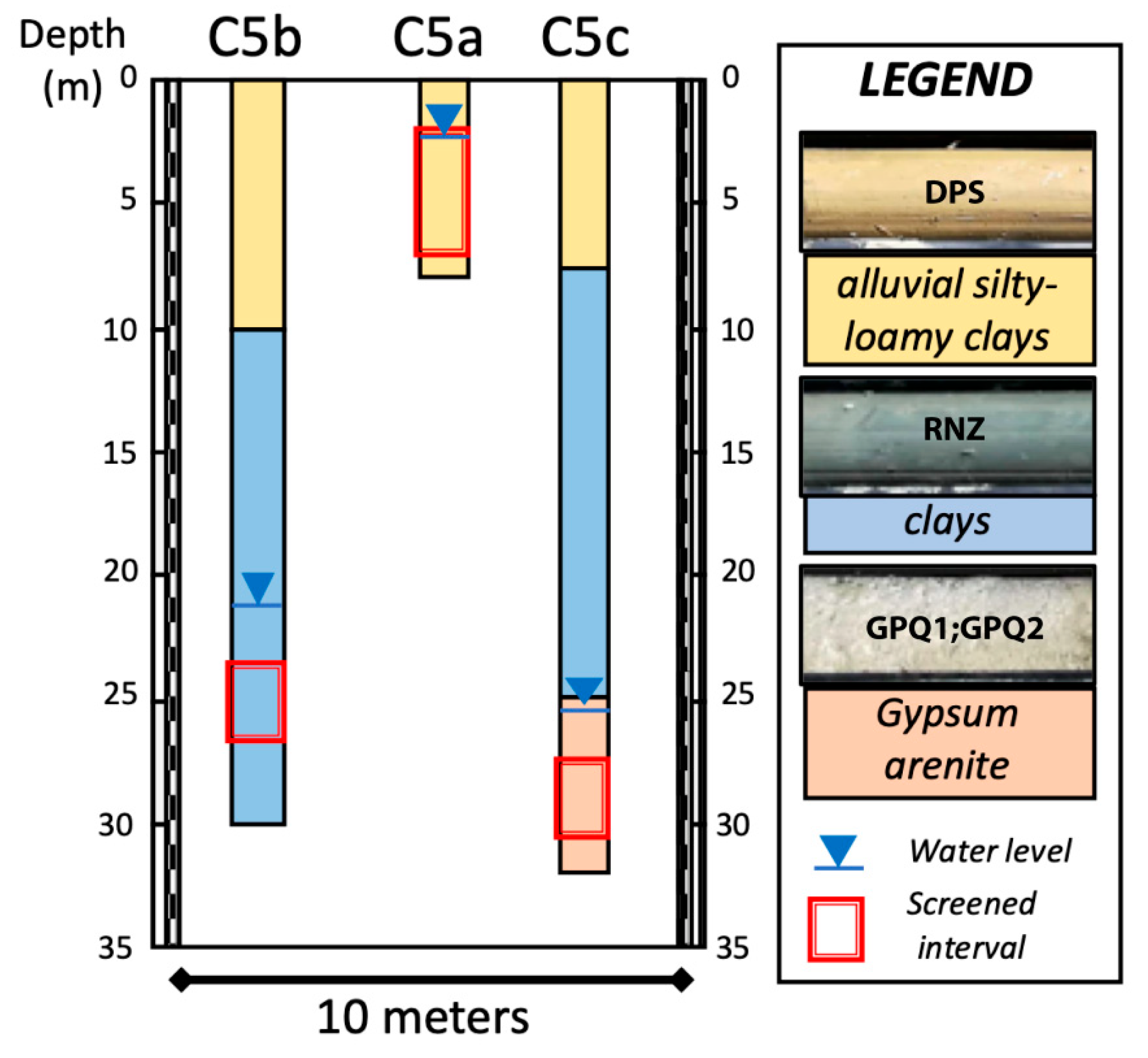

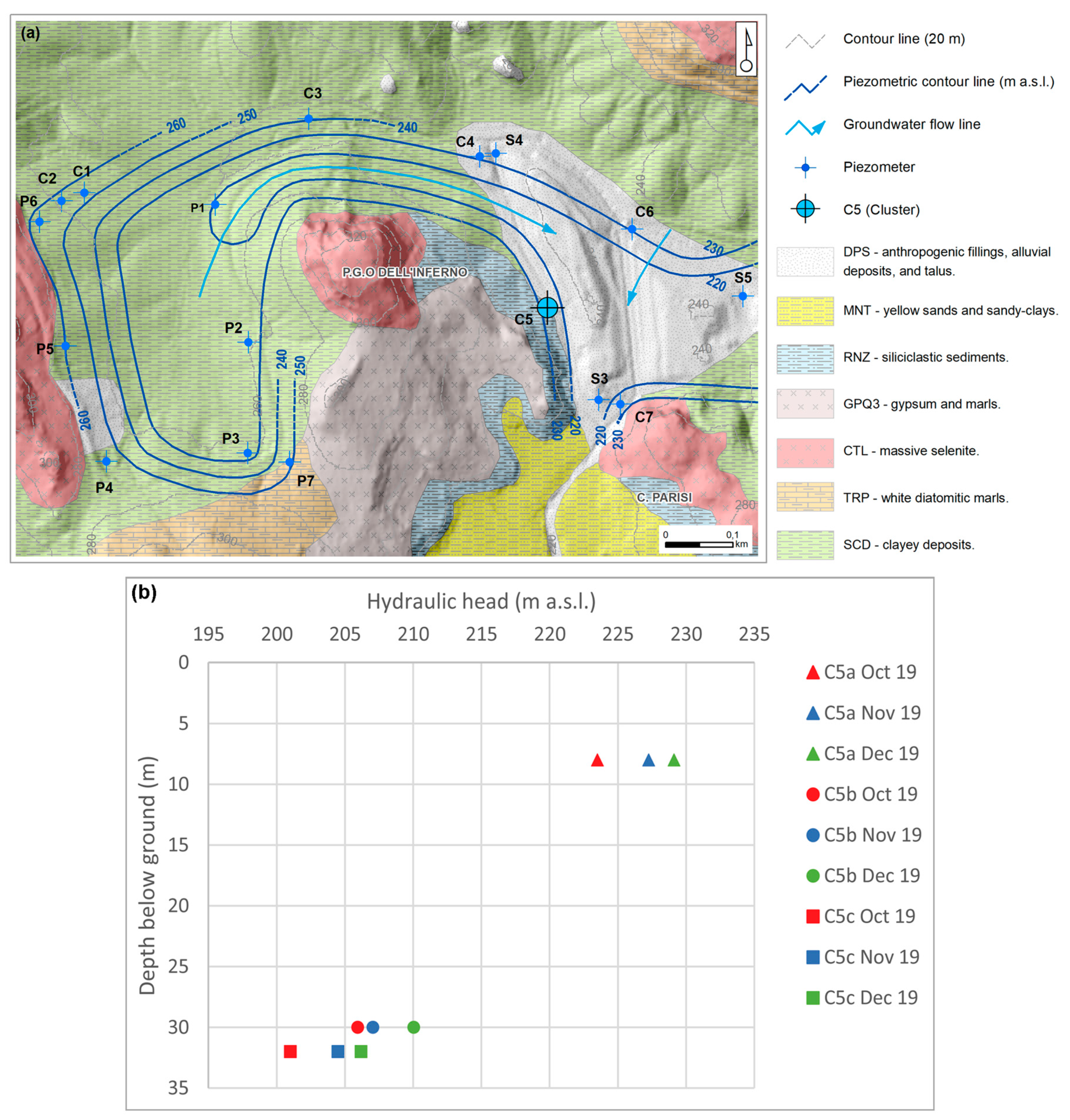

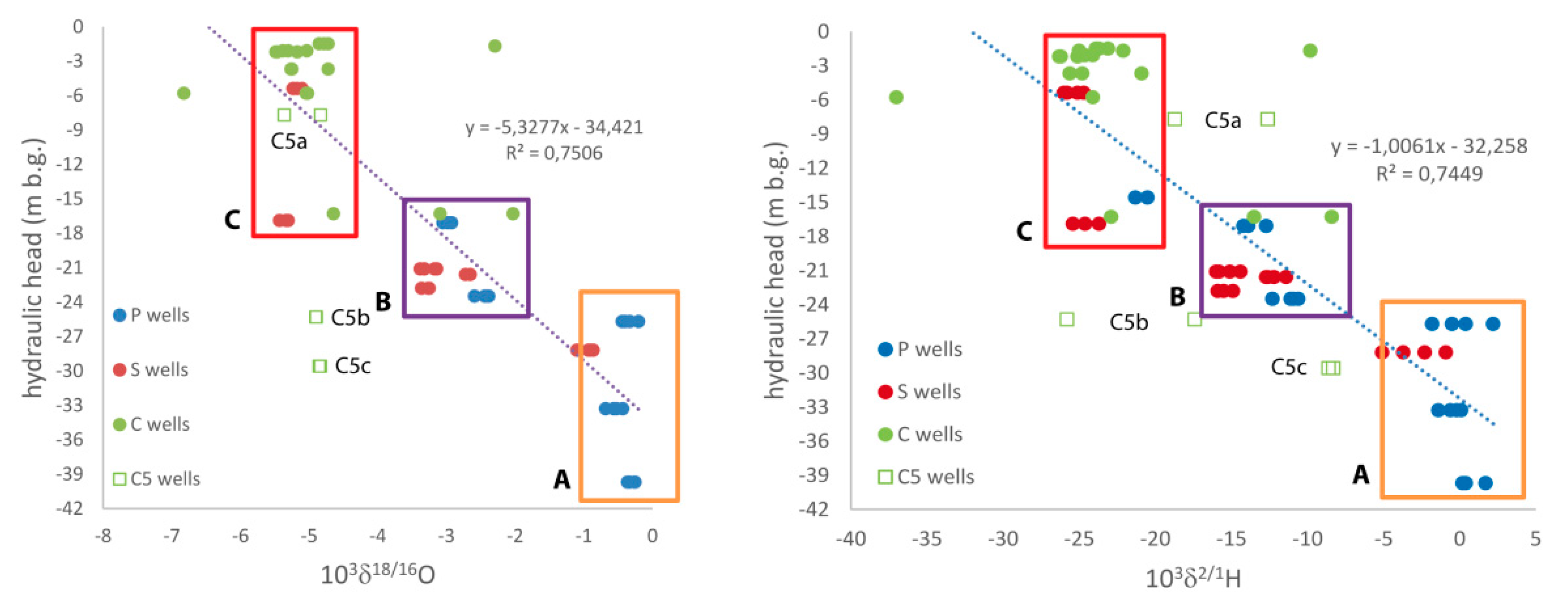
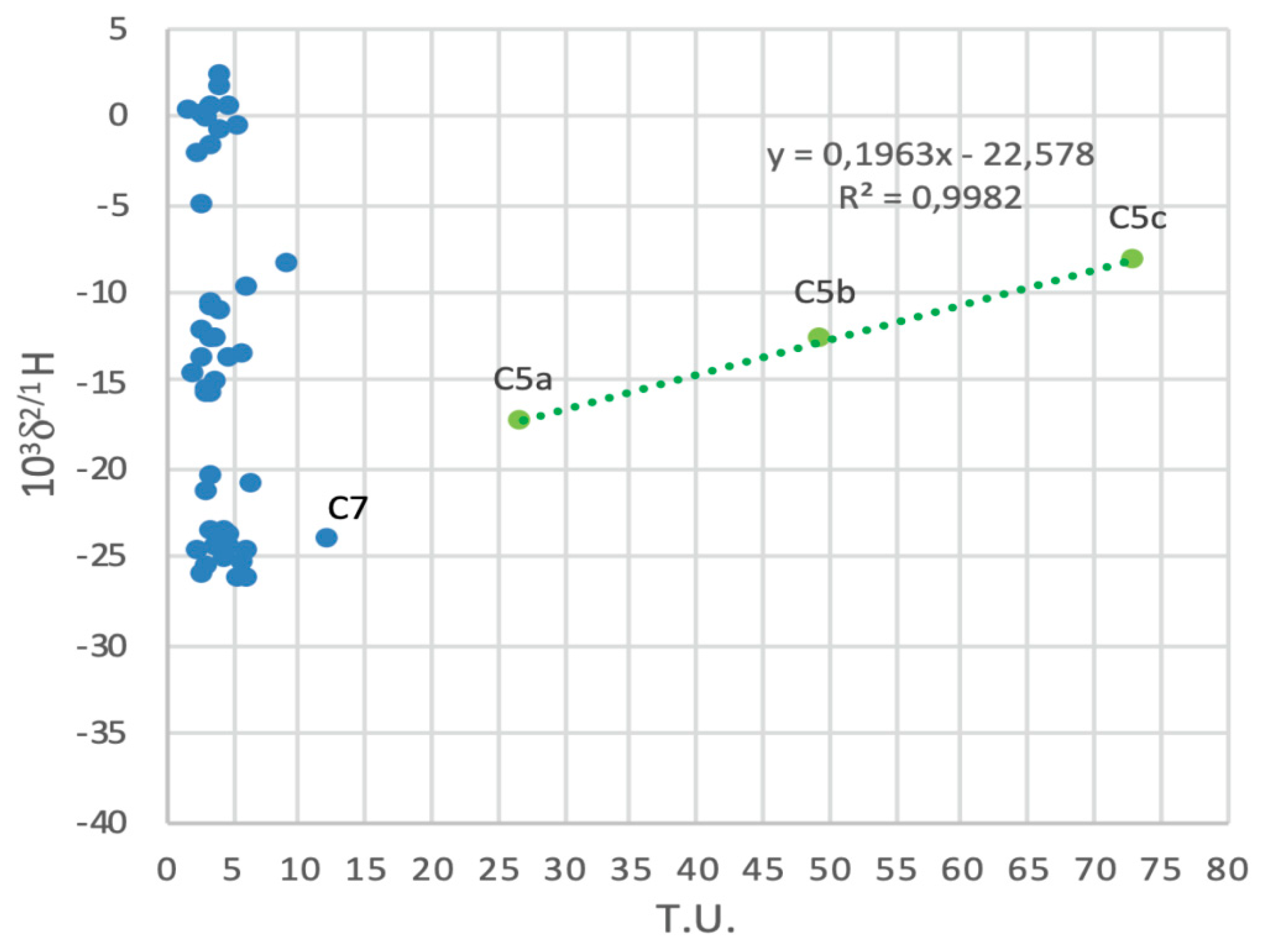

| Taxonomy | C5a | C5b | C5c |
|---|---|---|---|
| Aeromonas | 2.13% | 0.14% | 0.07% |
| Alcanivorax | 0.72% | 0.95% | 0.46% |
| Arcobacter | 1.67% | 0.13% | 1.12% |
| Candidatus Nitrotoga | 0.00% | 0.74% | 0.33% |
| Idiomarina | 0.20% | 0.08% | 0.84% |
| Limnobacter | 1.57% | 0.00% | 2.18% |
| Magnetospira | 0.18% | 0.73% | 0.31% |
| Marinobacter | 0.11% | 0.36% | 0.98% |
| Marinobacterium | 0.05% | 0.00% | 1.29% |
| Marinomonas | 1.23% | 0.00% | 0.30% |
| Nitrosomonas | 0.00% | 3.43% | 0.64% |
| Nitrospina | 0.06% | 1.91% | 0.36% |
| Oceanobacter | 0.12% | 3.82% | 0.46% |
| Parvibaculum | 0.28% | 0.42% | 1.19% |
| Pseudohongiella | 0.85% | 2.72% | 0.85% |
| Pseudomonas | 58.95% | 52.18% | 47.22% |
| Rehaibacterium | 0.17% | 7.38% | 2.29% |
| Rheinheimera | 2.50% | 0.00% | 0.55% |
| Roseovarius | 0.04% | 0.78% | 0.30% |
| Shewanella | 7.39% | 0.07% | 0.72% |
| Sphingobium | 1.60% | 0.00% | 1.06% |
| Sphingomonas | 0.92% | 0.11% | 0.44% |
| Thiobacillus | 0.00% | 0.19% | 1.34% |
| Vibrio | 0.00% | 0.03% | 5.77% |
| Taxonomy | Aerobic | Facultative Aerobic | Anaerobic | Facultative Anaerobic | Halophilic/ Halotolerant | Sulfate Reduction |
|---|---|---|---|---|---|---|
| Alcanivorax | + | + | ||||
| Arcobacter | + | + | + | |||
| Desulfatiglans | + | + | + | + | ||
| Desulfovibrio | + | + | + | + | ||
| Marinobacter | + | + | ||||
| Marinomonas | + | + | ||||
| Oceanobacter | + | + | ||||
| Pseudomonas | + | + | + | |||
| Shewanella | + | + | + | + | ||
| Vibrio | + | + | + |
| Taxonomy | Aerobic | Anaerobic | Halophilic/Halotolerant | Methanogenesis | Sulfate Reduction | Ammonia Oxidizing |
|---|---|---|---|---|---|---|
| Candidatus Nitrocosmicus | + | + | + | |||
| Candidatus Nitrosoarchaeum | + | + | + | |||
| Candidatus Nitrosopumilus | + | + | + | |||
| Halococcus | + | + | ||||
| Halogranum | + | + | + | |||
| Methanimicrococcus | + | + | + | |||
| Methanobacterium | + | + | + | |||
| Methanolobus | + | + | + | |||
| Methanothermobacter | + | + | + | + |
Publisher’s Note: MDPI stays neutral with regard to jurisdictional claims in published maps and institutional affiliations. |
© 2020 by the authors. Licensee MDPI, Basel, Switzerland. This article is an open access article distributed under the terms and conditions of the Creative Commons Attribution (CC BY) license (http://creativecommons.org/licenses/by/4.0/).
Share and Cite
Rizzo, P.; Cappadonia, C.; Rotigliano, E.; Iacumin, P.; Sanangelantoni, A.M.; Zerbini, G.; Celico, F. Hydrogeological Behaviour and Geochemical Features of Waters in Evaporite-Bearing Low-Permeability Successions: A Case Study in Southern Sicily, Italy. Appl. Sci. 2020, 10, 8177. https://doi.org/10.3390/app10228177
Rizzo P, Cappadonia C, Rotigliano E, Iacumin P, Sanangelantoni AM, Zerbini G, Celico F. Hydrogeological Behaviour and Geochemical Features of Waters in Evaporite-Bearing Low-Permeability Successions: A Case Study in Southern Sicily, Italy. Applied Sciences. 2020; 10(22):8177. https://doi.org/10.3390/app10228177
Chicago/Turabian StyleRizzo, Pietro, Chiara Cappadonia, Edoardo Rotigliano, Paola Iacumin, Anna Maria Sanangelantoni, Giulia Zerbini, and Fulvio Celico. 2020. "Hydrogeological Behaviour and Geochemical Features of Waters in Evaporite-Bearing Low-Permeability Successions: A Case Study in Southern Sicily, Italy" Applied Sciences 10, no. 22: 8177. https://doi.org/10.3390/app10228177
APA StyleRizzo, P., Cappadonia, C., Rotigliano, E., Iacumin, P., Sanangelantoni, A. M., Zerbini, G., & Celico, F. (2020). Hydrogeological Behaviour and Geochemical Features of Waters in Evaporite-Bearing Low-Permeability Successions: A Case Study in Southern Sicily, Italy. Applied Sciences, 10(22), 8177. https://doi.org/10.3390/app10228177









